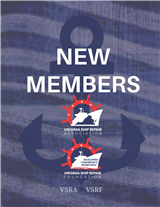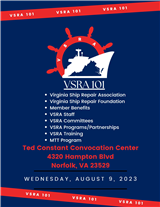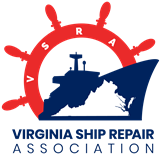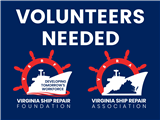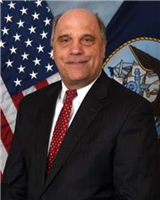
Frederick J. Stefany Assistant Secretary of the Navy for Research, Development and Acquisition | The May General Membership Luncheon meeting was held at ODU’s Chartway Arena, Big Blue Room on Tuesday, May 16, 2023. The guest speaker was Mr. Frederick “Jay” Stefany, Assistant Secretary of the Navy (ASN) for Research Development & Acquisition (Acting). He thanked Kevin Terry for his introduction, Bill Crow for the invitation to speak to industry, and Robbie Walker for the blessing of his speech. “May we live up to the higher calling.” He was impressed with VSRA’s committees and the job they are doing to get the issues for common problems resolved as a team. He stated that this is where the work gets done in an organization like this, whether a small or large company.
Next, Mr. Stefany moved to the national level speaking on workforce development. There’s a need to get into high schools to recruit students and retain them. We recognize that high schools and trade schools are where we need to be to keep us thriving. He believes that ship building, and ship repair is in a renaissance and is growing across the nation. We need more people to come into ship repair and building.
Mr. Stefany continued that ship repair, particularly in the Hampton Roads area, is about as big as it gets in size and complexity. During COVID, when people were shutting down and staying home, industry stayed open, and the workforce found a way to keep maintaining the ships. Today we continue that process. He believes our industry is a hero to the Nation. Without our industry, the Navy wouldn’t exist. Our Country and our freedom are epitomized in our Navy and Marine Corp. Industry makes it possible. Mr. Stefany said, “You are the Strength Behind the Fleet!”
Mr. Stefany mentioned that the Secretary of the Navy, Carlos Del Toro’s number one priority is strengthening the maritime gauntlets. Make no mistake, we have challengers such as China and Russia that we haven’t had in a lifetime. They would like to take our place. By keeping our maritime dominance with our forward forces in our Navy and Marine Corp out there and maintaining our top-of-the-line capabilities, that is what it’s about and industry does that, thank you!
Mr. Stefany stated that the CNO, Joint Staff, and Commodore Staff are putting the final touches on BITSTARZ. It’s an assessment of how many ships and submarines will be needed. This was last done in 2018 giving us the count of 355 ships. Now five years later, the number of ships required will be more like 370-380 with an additional 100 unmanned vessels on top of the 297 manned ships we have now. Once they are out there, they will need industry around the Country to maintain those ships. He sees a higher number being required, and a real commitment by the Navy, Marine Corp, and Congress to pay and put more money into ship building which eventually leads to ship repair.
Mr. Stefany continued stating that last year they delivered employment of the Aircraft Carrier Gerald Ford, and now the Ford is going on its first deployment. So those who work on the carrier side of the business, he said thank you! They’ve started the construction of a new class of frigates that will be coming to the east and west coast once built. They are in the process of supporting DDG51 construction with 10-15 new destroyers going under contract to be built in Hampton Roads this month. The new TIAGO and SWATH surveillance ships will be homeported in Hampton Roads. They are also working on a landing ship for the Marine Corp. There will be between 20 to 30 of these ships that will be smaller than a traditional amphibious, bigger than a landing craft and will be our first unmanned surface vessels in 2025. These are all going to require maintenance.
Mr. Stefany said that in the meantime, they need to give industry a predictable reasonable amount of level loaded maintenance. They are committed to work with leadership of industry to keep working in our yards. They are committed to keeping a predictable amount of work, so we know what is coming in the next year or two, and a longer term is coming.
Mr. Stefany confirmed that in 2026, the Navy will start decommissioning ships prior to their service life. The operational side of the business has concluded that these ships don’t contribute enough to the higher fight, specifically speaking of the LSD, Cruisers and Control Combat Ships. They are going hull by hull to see the condition of each ship and assess the remaining life for retirement. They don’t expect to retire as many ships as the list says, particularly the Amphib ships, which they expect they will be keeping longer. Older ships such as the Haley Burton class and Nimitz class ships will be extended another cycle as well as extending the Ike. The Secretary of the Navy himself is looking at all their ships. They will then make the decision to retire ships based on their condition.
Mr. Stefany stated that they are beginning the process of upgrading 25 of their DDG Flight IIA’s known as AMOD 2.0. This is a major combat system upgrade that will include a new electronic warfare system called SUBA and a new radar upgrade to SPY6. These 25 ships are being upgraded in the next 15 years in a significant dry dock effort requiring two years per ship. To support the effort on the DDGs, NAVSEA is establishing a Rotatable Pool for DDG Avails with DDG Shafting, SLADs, VCHT Systems parts and Overboard Discharge Valves. The Williams will be the first ship to start on the East Coast in 2024.
Mr. Stefany went on to say that they are creating a unique program office to manage this effort, putting a Captain (O6) that is solely in charge of this modernization effort. That will stop the diverting of attention allowing the O6 and his team to focus and work with industry to get the most capability in the most effective way possible. The 2024 budget, for the first time in his career, fully funds maintenance for the fleet. The model they produced allows funding at 100%. This will result in an increase in all the homeports in the amount of work that will be going on.
Mr. Stefany continued that the Secretary of the Navy, Carlos Del Toro, is concerned that China’s Navy is getting bigger than what we have. How did they get that way? They have a large commercial ship building/repair capability. There isn’t a lot of commercial ship repair work in the United States. He wants to figure this out and work with politicians to figure out how to get more commercial ship building and repair in the United States. It’s not going to happen overnight, even if we can go from 1% to 3%. To do this, it will require building the infrastructure with trades to support.
Mr. Stefany made sure to mention the efforts of Fire Safey, appreciating the attention industry has given to Fire Safety since the Bonhomme Richard. The stats show that class A fires are down with the help of Navy crews as well as what industry does, putting more focus on fire safety and the prevention of having another Bonhomme Richard incident.
Mr. Stefany then referred to the current Ukraine situation. Prior to this time, we were able to use FedEx to get parts where they are needed and used the internet to communicate. In a wartime environment, we may not be able to do that, and we may not be able to get the ship back to port when they are damaged. If the internet or radar goes down, we cannot communicate as effectively. Tech reps cannot get to a ship in a wartime environment. How do we maintain a ship when it’s out? He wants the Navy to practice so that crews are prepared to do what they can to keep the ships afloat.
Mr. Stefany closed with the mention of The Battle of the Coral Sea. Americans and Australians came together to stop the Japanese from invading Papua New Guinea. Our Aircraft Carrier Yorktown was damaged and was sent back to Pearl Harbor for repairs. That is when Admiral Nimitz discovered that Japan was going to attack Midway. They had Yorktown ready to go back out within three days. Yes, we lost that ship, but took that victory. Fast forward to today, if given the same situation, could we repair a ship in three days to get it back in the fight?






